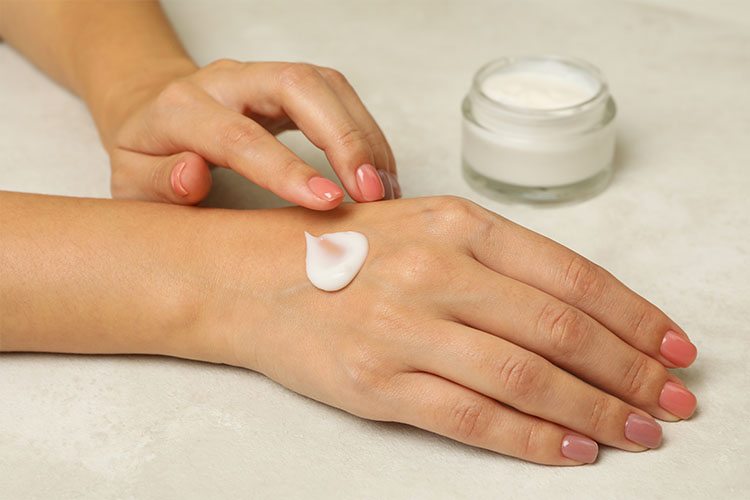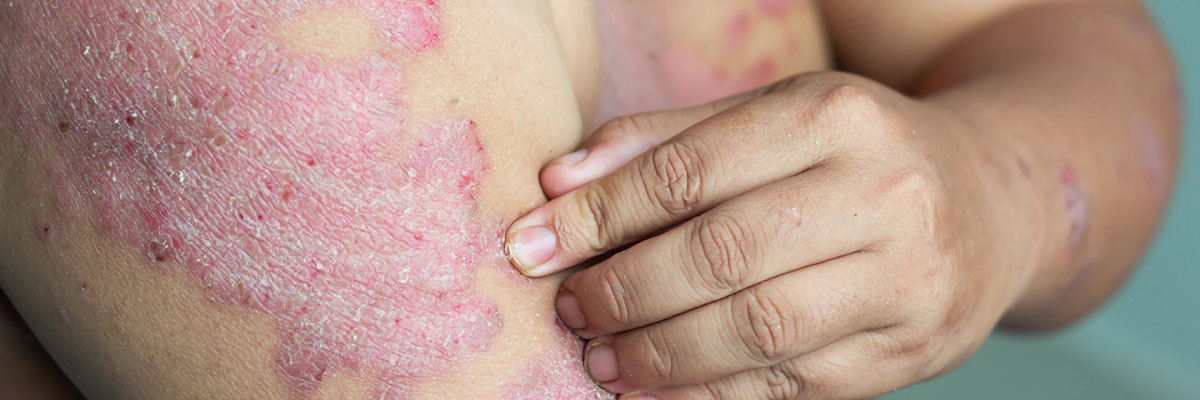Summary
Psoriasis is a hereditary skin condition that causes thickening, inflammation, redness, itching, and scaling of the skin. It often appears on areas like the scalp, back, elbows, knees, and other body parts. In individuals with psoriasis, the skin cells regenerate at a much faster rate than normal. While skin typically regenerates every 10 to 30 days, in psoriasis, this process occurs within 3 to 4 days. This rapid turnover prevents the skin from shedding normally, leading to visible, thickened patches and discomfort.
The exact cause of psoriasis is not fully understood, but doctors believe it is linked to an immune system malfunction, particularly involving T-cells. Normally, T-cells help the body fight off harmful bacteria and viruses. However, in psoriasis, these T-cells mistakenly attack healthy skin cells, treating them as if they were foreign invaders. This immune response triggers an overproduction of skin cells, leading to the accumulation of scales and inflammation characteristic of psoriasis.
To manage psoriasis, doctors may prescribe topical treatments such as corticosteroids, vitamin D analogs, and other creams to reduce inflammation and scaling. In more severe cases, oral or injectable medications may be recommended, as well as light therapy (phototherapy) to help slow skin cell production and reduce symptoms. Proper treatment can help alleviate symptoms and improve quality of life for those affected by psoriasis.
Table of Contents
Symptoms of Psoriasis

Psoriasis can present in various forms, but certain symptoms are common across types. These include:
- Red patches on the skin. Psoriasis often causes well-defined, red patches that can appear on different parts of the body.
- Raised, thickened patches. Affected areas may feel elevated and thicker than surrounding skin due to rapid cell buildup.
- Thick scaling that resembles dandruff. These patches often develop a layer of silvery scales, which can flake off and resemble dandruff, especially when they appear on the scalp.
- Dry, cracked skin with bleeding. The skin in affected areas may become extremely dry, leading to painful cracks that can sometimes bleed.
- Itching, burning, or soreness. Psoriasis patches are often itchy, and some people experience burning or pain in the affected areas.
- Thickened skin under the nails. Psoriasis can affect nails, causing them to thicken, develop ridges, or even separate from the nail bed.
- Joint swelling and stiffness. In cases of psoriatic arthritis, individuals may experience inflammation in the joints, leading to pain and stiffness.
Psoriasis flare-ups can be triggered by factors like stress, smoking, alcohol, and other environmental or lifestyle factors. These patches typically do not resolve quickly and can persist for weeks or even months without treatment. Identifying and managing triggers is essential for reducing the frequency and severity of flare-ups.
Types of Psoriasis
Psoriasis has several types, each with distinct characteristics and symptoms. Here are the main types:
- Plaque psoriasis. This is the most common form, affecting 80-90% of individuals with psoriasis. It appears as raised, scaly patches on the skin, typically found on the elbows, knees, back, and scalp. These patches, or plaques, usually range from 1 to 10 centimeters in size and can cause discomfort and itching.
- Guttate psoriasis. Characterized by small, droplet-shaped patches, guttate psoriasis often appears on the arms, legs, scalp, and sometimes on the face. It tends to affect children and young adults and may be triggered by infections such as strep throat.
- Flexural (or inverse) psoriasis. Unlike other types, flexural psoriasis appears as smooth, red patches without scales. It commonly occurs in areas with skin folds, such as the armpits, groin, and under the breasts, where moisture and friction can irritate the skin.
- Pustular psoriasis. This severe form of psoriasis is marked by pus-filled blisters surrounded by red skin. It often affects the hands and feet, but in some cases, it can spread across the body, leading to intense discomfort and potential complications.
- Erythrodermic psoriasis. This rare and severe type of psoriasis can cover most of the body with red, burned-looking patches and is considered a medical emergency. Erythrodermic psoriasis disrupts the body’s temperature regulation and can cause severe itching, pain, and swelling, requiring immediate medical attention.
- Psoriatic arthritis. This type affects not only the skin but also the joints, leading to symptoms of both psoriasis and arthritis. It often impacts the fingers, toes, and spine, causing pain, swelling, and stiffness in the affected joints.
- Nail psoriasis. Often mistaken for a fungal infection, nail psoriasis causes thickened, pitted patches under the nails. It can lead to discoloration, nail splitting, and even nail loss in severe cases.
- Scalp psoriasis. Common in individuals with plaque psoriasis, scalp psoriasis causes red, scaly patches on the scalp and hairline. It may lead to itching, soreness, and even hair loss if left untreated.
Understanding the different types of psoriasis is crucial for accurate diagnosis and effective treatment, as each type has unique symptoms and may require tailored approaches for management.
Diagnostic Procedures for Psoriasis
Diagnosing psoriasis involves examining skin symptoms, reviewing medical history, and sometimes conducting additional tests to confirm the condition. Here are the primary diagnostic steps for psoriasis:
- Physical examination and medical history. A doctor will typically begin by examining the affected areas of the skin and asking about symptoms, family history of psoriasis, and any potential triggers. This visual inspection is often sufficient for diagnosis, especially if symptoms are classic.
- Skin biopsy. In cases where diagnosis isn’t clear, a small sample of the skin (biopsy) may be taken and examined under a microscope. A biopsy can help distinguish psoriasis from other skin conditions, such as eczema, and confirm specific types of psoriasis.
- Blood tests. Although blood tests aren’t usually needed to diagnose psoriasis, they can be used to rule out other conditions with similar symptoms or to check for conditions linked to psoriasis, such as psoriatic arthritis.
- X-rays or imaging tests (for suspected psoriatic arthritis). For individuals who may have psoriatic arthritis, imaging tests like X-rays or MRIs may be used to assess joint health and identify any inflammation or joint damage.
- Nail examination. Psoriasis can affect the nails, causing changes like pitting, discoloration, or thickening. A close examination of the nails can provide additional clues for diagnosing specific types of psoriasis.
These diagnostic procedures help doctors accurately identify psoriasis, determine its type, and create an effective treatment plan. Early diagnosis and tailored treatment can help manage symptoms and reduce the impact of psoriasis on daily life.
Complications of Untreated Psoriasis
When psoriasis is left untreated, it can lead to a range of complications that impact both physical health and quality of life. Here are the primary risks associated with unmanaged psoriasis:
- Psoriatic arthritis. Untreated psoriasis can progress to psoriatic arthritis, which causes painful inflammation, stiffness, and swelling in the joints. Over time, psoriatic arthritis can lead to joint damage and permanent disability if not properly managed.
- Skin infections. Chronic scratching and open lesions from psoriasis patches can increase the risk of bacterial and fungal infections. Infections may cause additional pain, redness, and swelling, further aggravating the condition.
- Eye conditions. People with psoriasis are at higher risk for eye problems such as conjunctivitis (pink eye), uveitis (inflammation of the eye’s middle layer), and dry eye syndrome. These conditions can cause discomfort and may impact vision if untreated.
- Cardiovascular disease. Studies show that psoriasis is associated with an increased risk of cardiovascular problems, including high blood pressure, heart attack, and stroke. Chronic inflammation in the body from psoriasis can contribute to the development of these serious health issues.
- Metabolic syndrome. Psoriasis is linked to metabolic syndrome, a group of conditions that include obesity, high blood pressure, and high blood sugar. Metabolic syndrome increases the risk of heart disease, diabetes, and other health complications.
- Mental health challenges. The visible symptoms of psoriasis can lead to low self-esteem, social anxiety, and even depression. The emotional toll of managing a chronic skin condition can significantly affect mental health, especially if symptoms impact social interactions or professional life.
- Kidney disease. Severe or poorly managed psoriasis has been linked to an increased risk of chronic kidney disease, especially in individuals with long-standing, widespread psoriasis.
- Reduced quality of life. Persistent symptoms, discomfort, and the social and psychological impact of psoriasis can reduce overall quality of life. It can interfere with work, relationships, and daily activities.
Effective treatment of psoriasis can help manage symptoms, reduce flare-ups, and lower the risk of these complications. Early diagnosis and consistent care are essential to minimize the long-term effects of psoriasis and maintain a better quality of life.
Causes of Psoriasis
Psoriasis is classified as an autoimmune disorder, where, for unknown reasons, the body’s immune system mistakenly attacks healthy skin cells instead of protecting them.
In this condition, the problem lies with the T-cells, a type of white blood cell that normally helps defend the body by fighting off harmful microbes. However, in people with psoriasis, the T-cells mistakenly target healthy skin cells as if they were harmful invaders. This triggers an overproduction of skin cells, leading to the thickening and scaling characteristic of psoriasis. As new skin cells are generated every few days instead of the usual weeks, they build up on the skin’s surface, creating red, scaly patches.
Prevention of Psoriasis

While psoriasis is hereditary and cannot be completely prevented, there are ways to reduce flare-ups and manage symptoms:
- Use moisturizer regularly. Keeping the skin hydrated helps prevent dryness and scaling. Doctors recommend thick moisturizers like petroleum jelly for people with psoriasis, as it locks in moisture effectively.
- Bathe daily with care. Daily bathing helps remove scales and keeps the skin clean. Pay special attention to areas like skin folds, scalp, elbows, and knees. Use lukewarm water and avoid harsh soaps to prevent irritation.
- Use a humidifier at home. A humidifier helps maintain moisture in the air, which prevents skin dryness, especially during colder months when indoor heating can dry out the skin.
- Wear appropriate clothing in cold weather. Protect your skin from dry, cold air by wearing long sleeves and covering up as much as possible to prevent exposure to harsh conditions.
- Avoid medications that can trigger flare-ups. Certain drugs, such as lithium, beta-blockers like propranolol, and some anti-inflammatory medications, can worsen psoriasis. Consult your doctor about alternatives if you have psoriasis.
- Handle grooming with care. Be cautious when cutting nails or shaving, as cuts or abrasions can lead to infection and potentially worsen psoriasis symptoms.
- Get moderate sun exposure. Sunlight can slow skin cell growth and help alleviate psoriasis symptoms. About 20 minutes of sun exposure daily can be beneficial, but avoid sunburn, as it can worsen the condition.
- Reduce stress. Stress can trigger psoriasis flare-ups, so it’s helpful to practice relaxation techniques such as yoga, meditation, or breathing exercises to keep stress levels in check.
- Limit smoking and alcohol consumption. Both smoking and drinking alcohol can exacerbate psoriasis symptoms, so reducing or avoiding these habits may help prevent flare-ups.
- Exercise regularly to maintain a healthy weight. Keeping a balanced weight can reduce inflammation and lower the risk of flare-ups, especially in those prone to psoriasis.
Following these lifestyle adjustments can help manage psoriasis symptoms, prevent triggers, and improve overall skin health.
Risk Factors for Psoriasis

Psoriasis can affect people of all ages, but certain factors increase the likelihood of developing this condition:
- Family history of psoriasis. Psoriasis often runs in families. If one or both parents have the condition, there is a higher chance that their children may inherit it.
- Infections. Bacterial and viral infections, such as HIV and strep throat, can weaken the immune system, which may trigger psoriasis symptoms, especially in those with a family history of the condition.
- Obesity. Excess body weight contributes to more skin folds, where psoriasis patches commonly appear. In people who are overweight, psoriasis may be more persistent and widespread, particularly in areas where skin rubs together.
- Smoking. Studies show that nicotine in cigarettes interferes with healthy skin cell growth and contributes to inflammation, which can exacerbate psoriasis symptoms. Smoking is also associated with more severe forms of psoriasis and can reduce the effectiveness of treatments.
- Chronic stress. Constant stress causes the body to release chemicals that increase the inflammatory response, making the skin more prone to flare-ups. Psoriasis symptoms may become more pronounced when a person is under chronic stress.
Understanding these risk factors can help individuals make lifestyle adjustments and seek early intervention if necessary. Avoiding certain triggers, like smoking and stress, may help manage or reduce the frequency of psoriasis flare-ups.
Psoriasis FAQs
Psoriasis is a chronic autoimmune skin condition that can impact daily life. Here are some common questions to help you better understand this condition.
- What is psoriasis?
Psoriasis is a chronic autoimmune disorder that accelerates skin cell growth, leading to thick, scaly patches on the skin. It often affects areas like the elbows, knees, scalp, and back. - What causes psoriasis?
The exact cause is unknown, but psoriasis is believed to be linked to immune system issues where T-cells mistakenly attack healthy skin cells. Genetics, environmental triggers, infections, stress, and other factors may also play a role. - Is psoriasis contagious?
No, psoriasis is not contagious. It cannot be spread through skin contact, sharing personal items, or exposure to the affected areas. - What are the symptoms of psoriasis?
Common symptoms include red patches of skin covered with thick scales, dry and cracked skin that may bleed, itching or soreness, thickened or ridged nails, and swollen or stiff joints if psoriatic arthritis is present. - Are there different types of psoriasis?
Yes, there are several types, including plaque psoriasis (the most common form), guttate psoriasis, inverse (or flexural) psoriasis, pustular psoriasis, erythrodermic psoriasis, scalp psoriasis, nail psoriasis, and psoriatic arthritis. - Can psoriasis be cured?
Currently, there is no cure for psoriasis, but treatments can help manage symptoms and reduce flare-ups. Common treatments include topical creams, light therapy, and oral or injectable medications. - How is psoriasis treated?
Treatment varies depending on severity and type. Options include topical corticosteroids, vitamin D analogs, phototherapy, systemic medications (like methotrexate), and biologics to target immune responses more specifically. - What triggers psoriasis flare-ups?
Common triggers include stress, smoking, infections, cold and dry weather, alcohol consumption, and certain medications. Identifying personal triggers can help manage flare-ups. - Is psoriasis hereditary?
Yes, psoriasis has a genetic component. Individuals with family members who have psoriasis are at a higher risk, although not everyone with a family history will develop the condition. - How can I manage psoriasis at home?
To manage psoriasis at home, keep skin moisturized, avoid known triggers, practice stress-relief techniques, follow a healthy lifestyle, and use gentle skin care products. Consult with a healthcare provider before starting any new treatments.


